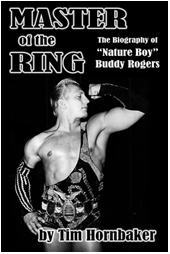
|
|
By the late 1950s, "Nature Boy" Buddy Rogers was an unparalleled superstar, but there was one honor he coveted … the National Wrestling Alliance world heavyweight championship. To that point, the hostile environment of wrestling politics had stalled his push to the throne, but Rogers overcame the obstacles in his path until, finally, with the right friends in high places, he was given a title match against champion Pat O'Connor in Chicago's Comiskey Park before a record crowd of 38,000 spectators. By the end of the night, Rogers was the new heavyweight champion of the world! After the match, he strapped on the title belt, stood in the center of the ring, and in his typically arrogant fashion, announced:
"To a nicer guy, it couldn't happen!"
Backstage assaults and injuries almost derailed his title reign, and in the midst of his historic run, Rogers suffered serious health problems, and a cloud fell over his future on the mat. In May 1963, he defended the title against Bruno Sammartino, the popular "Italian Superman," at Madison Square Garden. Since then, wrestling fans have asked countless questions about what really happened on that fabled evening. Author Hornbaker dissects the incident, as well as Buddy's entire life, to answer those questions and clear up some of the misconceptions and lies told about Buddy. You will learn the entire "Buddy Rogers Saga" from beginning to end as Hornbaker focuses on the backstage politics, secret strategies, and different perspectives, including never-before-heard inside sources from that time-frame, including Rogers' former manager, Bobby Davis.
In this book, a detailed look at one of the most important figures in wrestling history, the truth of Buddy Rogers is told — in all of his stunning (and colorful) glory. It's a story with boundless action, mayhem, and excitement.

|
|
|
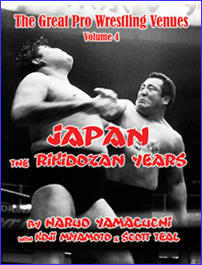
|
|
With all the press Antonio had been getting, he developed a conceited attitude towards other wrestlers. Three nights earlier, on May 18 in Ube, Ike Eakins decided to teach him a lesson in humility and punished him in the ring by beating him with his fists. On the night before this in Osaka, Hercules Romero stretched Antonio during their match. On this night in Okayama, Bill Miller & Karl Gotch joined Eakins to give Antonio another sound thrashing, this time in the dressing room.
— Excerpt from "Japan: The Rikidozan Years, 1951-1963"
Wrestling historian Haruo Yamaguchi, along with Koji Miyamoto & Scott Teal, pull together the details surrounding wrestling’s origins in Japan. Professional wrestling had been a staple in most American cities from the early 1900s, but it didn't take hold as a regular sport in Japan until 1954 when a former sumo wrestler named Rikidozan brought well-known American wrestlers to the Land of the Rising Sun.
If you’re a fan of Japanese pro wrestling, this book is a unique and invaluable resource — a comprehensive account of the origins of the sport in Japan and every known match between Sept. 30, 1951, and Rikidozan’s death in Dec. 1963. More than 978 shows are covered, along with details surrounding the matches, the talent, and the promotion.
This is the most complete analysis of the pioneer days of pro wrestling in Japan. Readers will discover how the sport has evolved and learn about milestone moments that brought it to prominence.

|
|
|
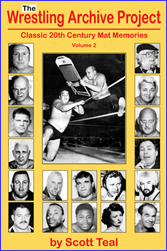
|
|
Homer O’Dell took over at that point. He pulled out a .44 Magnum that wasn’t even loaded, stood over me, and that’s what kept the people back. Two or three guys then pulled me out, but it was Homer standing his ground that kept the crowd away. Malenko was leaking like a sieve and took 33 stitches in his abdomen.
— Excerpt from an interview with Bob Orton, Sr. in "Wrestling Archive Project, volume 2"
In this second volume of "Wrestling Archive Project," you will find interviews with the professional wrestling legends of yesteryear. Scott Teal, the man behind Crowbar Press, conducted most of these interviews in the days when the wrestlers refused to open up and break the code of "kayfabe." And yet, because of his friendship with them over several decades, they talked openly and told their stories in a frank, candid manner.
The "MAIN EVENT" for this volume is an interview with KILLER KARL KOX. Karl steadfastly refused to grant an interview to anyone other than Scott, and he leaves no stone unturned as he tells his story. You’ll feel as if you’re sitting across the kitchen table from Karl as he relates his life story and talks about the wrestling business and the people with whom he crossed paths during his career.
Three other exclusive, never-before-published interviews appearing in print for the first time are with Jackie Fargo, Larry Cheatham & Kody Kox, and filling out the 386-page book are interviews with Bob Orton Sr., Count Billy Varga, Bulldog Bob Brown, Gentleman Ed Sharpe, J Michael Kenyon, Lou Thesz, Maniac Mike Davis, Sailor Art Thomas, Karl Von Stroheim, Tom Jones & Violet Ray. They all open up to Scott with details about their lives and careers as they have with no one else — before or since. Plus, Jody (Assassin) Hamilton talks about his brother, the Missouri Mauler. Finally, we have interviews with two legends of the American Wrestling Association (AWA) conducted by Minnesota wrestling historian George Schire.

|
|
|

|
|
We thought the press conference had been a rousing success; at least, until we heard news of the criminal charges being filed by the media against Nikita. Less than an hour after the press conference ended, every media outlet in Ludhiana was talking about the incident. They didn’t miss a thing … the table being turned over, raised voices, challenges of fights to the death, and all the mayhem that ensued when the media made their hasty exit. Several news anchors reported live from the hotel, with media vehicles surrounding the building.
— Excerpt from "Pain Torture Agony
Ron Hutchison, trainer of some of World Wrestling Entertainment’s biggest superstars, is hailed as one of pro wrestling’s unsung heroes.
His story begins as a wrestler on Canada’s east coast, but his journey takes us around the world to India, Japan, and the U.S. after Ron hangs up his trunks and becomes a trainer at the world-famous Sully’s Gym in Toronto. It is an account filled with history and insight into the fascinating world of pro wrestling, as well as tales of dreamers, muscleheads, a bomb threat, machine guns, Yakuza, midgets, and even a visit to the Playboy mansion in California.
With a foreword written by WWE Hall of Famer Adam (Edge) Copeland, the narrative is enhanced by original artwork drawn by Adam during his formative years, in addition to the first-time reproduction of Adam’s winning essay that earned him free wrestling training at Sully’s Gym. Also featured are rare photos of superstars Trish Stratus, Beth Phoenix, Gail Kim, Christian (Jason Reso), Johnny Swinger & Joe E. Legend, giving readers never-before-revealed insight into their training and developmental years.
This book is a compelling, inside-look at the tough world of pro-wrestling, but told in an informative and often humorous manner. Fasten your seatbelt as Ron Hutchison takes you on an exciting four-decade journey into the wild, no-holds-barred, wacky & amazing world of professional wrestling.

|
|
|
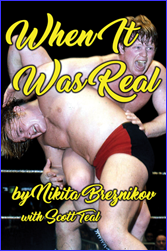
|
|
Near the end of the show, a strange thing occurred. An announcement was made that Bruno would be defending the WWWF title against Don Leo Jonathan on the Jan. 14, 1974 card. Morales was still champion at the time and it wasn’t until 19 days later that he would drop the belt to Stan Stasiak, who, in turn, would lose it to Sammartino nine days later … in the Garden. What was up with that?
— Excerpt from "When It Was Real"
If you want to take a trip back to your childhood, your younger, less-stressful days, then journey with us back into the magical world of WWWF professional wrestling during the years 1970 to 1979 … a time "when it was real" … a time before Hulkamania took the world by storm.
For wrestling fans, there was no feeling like walking into Madison Square Garden, Philadelphia Spectrum, Baltimore Civic Center, Boston Garden, and countless smaller arenas in every town in the Northeast, and thousands of people set everything aside to watch wrestling on TV and cheer on their heroes like Bruno Sammartino & Bob Backlund.
Escape with Nikita as he transports you back to an era when wrestling was presented in an entertaining manner, but framed as legitimate competition. Escape once again as we did back in the day.

|
|
|

|
|
Suddenly Cornette goes crazy and says he knows who they are! The Kids then score a stunning upset. As the crowd erupts from the perceived "upset," Cornette announces that the New Kids are ... Owen Hart & Chris Benoit. He’s seen tapes of these guys from all over the world and that the Royal Family has been "hornswoggled." Lance Russell is at ringside quickly interviewing the surprise winners, who announce their intentions to go after titles. The guys are shaking hands with the crowd, etc., while Ross is extolling their virtues. Cornette is going bananas, mumbling that "Mama’s attorneys are supposed to have handled this." Ross asks him what he means by that, but Cornette declines.
— Excerpt from "They Call Me Booker"
In the year 1990 in an alternate universe, Ted Turner hired an unknown and unproven booker to book World Championship Wrestling and save the company from what seemed to be impending disaster. Join author and wrestling history buff Jeff Bowdren as he rewrites and tweaks the storylines and matches he created when he penned a regular column — "Bowdren the Booker" — in the pages of the "Wrestling Observer Newsletter" in 1990 and 1991.
Imagine "what if" ...
... wrestling legend Bill Watts joined the WCW promotion and brought wrestlers loyal to him from his Universal Wrestling Federation, with his initial goal being to rid pro wrestling of the Four Horsemen?
... Owen Hart & Chris Benoit came in to feud with Jim Cornette's Midnight Express in an attempt to settle a personal family grudge?
... Ric Flair was a babyface and teamed up with Ricky Steamboat, and Brad Armstrong a heel who joined forces with Buddy Landel?
— AND THE MOST IMPORTANT QUESTION —
... what if Jeff Bowdren booked WCW?
"WHAT IF?" That's what we ask and resolve in "They Call Me Booker."

|
|
|
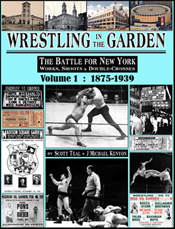
|
|
"How about that hot rasslin’ war featuring Jack Curley’s 71st Regt. Show and Jack Pfefer’s Hippodrome circus tonite? … the two shows are less than a mile apart, which indicates that somebody is stepping on the commission’s tootsies … only a week ago, Pfefer and Curley were partners … and today they’re not talking to each other!"
— Excerpt from "Wrestling in the Garden, volume 1"
There has always been something special about attending an event in New York City — sporting events, theater, movies, concerts — and even though wrestling fans in the Northeast loved their local venues, when push came to shove, the one place they’d rather see wrestling than any other was Madison Square Garden.
This is the story of pro wrestling’s power brokers, from Jack Curley to the man who controls the wrestling business today — Vince McMahon, Jr. Included, when available, are attendance and gate figures, match stipulations, match run times, wrestlers real names and aliases, and statistics, all laced with fascinating information from the Crowbar Press files.
This book, containing every wrestling event that took place in the Garden between Nov. 24, 1875, and March 30, 1938, is the definitive, exhaustive record of professional wrestling in Madison Square Garden ... The World’s Most Famous Arena!

|
|
|

|
|
—When Larry and I climbed into the ring, the house lights were still down. The only lighting was the spotlight on the ring, so I still couldn’t see anything outside of the ring. Of course, the house lights stayed down while Rocca and Perez made their grand entrance to the ring. I didn’t see the people until they cut the spotlights and brought the house lights up. This is no exaggeration. I’m not just saying this. My jaw actually dropped and I stood there with my mouth open. I thought, "My God! I’ve never seen this many people in one place in my entire life."
— Excerpt from "Wrestling in the Garden, volume 2"
There has always been something special about attending an event in New York City — sporting events, theater, movies, concerts — and even though wrestling fans in the Northeast loved their local venues, when push came to shove, the one place they’d rather see wrestling than any other was Madison Square Garden.
This is the story of pro wrestling’s power brokers, from Jack Curley to the man who controls the wrestling business today — Vince McMahon, Jr. Included, when available, are attendance and gate figures, match stipulations, match run times, wrestlers real names and aliases, and statistics, all laced with fascinating information from the Crowbar Press files.
This book, containing every wrestling event that took place in the Garden between Feb. 22, 1949, and Sept. 10, 2019, is the definitive, exhaustive record of professional wrestling in Madison Square Garden ... The World’s Most Famous Arena!

|
|
|

|
|
It quickly became an era of sabotage and backstabbing within the company. In addition to badgering me to drop the FCF title, H&M gave talent misleading information, contrary to the direction I gave them as match booker and creative director. They began to poison the roster by talking badly about me, which set an errant example to the younger talent, especially about respect. What they didn’t realize was that there were some amongst the crew who were telling me everything that had been said behind my back. The smarter members of the FCF roster quickly realized that H&M were trying to kill the golden goose.
— Excerpt from "Battleground Valhalla"
Wrestler, Rocker, Renaissance Man ...
From humble beginnings in Canada, Michael Majalahti, the son of an immigrant preacher, aspired to become somebody from an early age. As an outsider to his peers during his youth, Michael took the path less traveled; the road of the lone wolf. As "The Rebel" StarBuck, he became one of the most accomplished European pro wrestlers of the Y2K era and stands, arguably, as the most celebrated wrestler ever from the Nordics. His story is bound to both enthrall and inspire you!
"Against all odds, Mike reached for the stars and achieved his dreams of becoming a world-renowned wrestler and musician ... sounds familiar doesn't it? His story is inspiring and sensational and proves you can do anything you set your mind to! I highly recommend this book."
— Chris Jericho

|
|
|

|
|
One day, Dave Meltzer and I were in a hotel lobby in Japan. Kevin Von Erich says, "Let me ask you something ... any of you guys know that dirtsheet writer from California?"
Meltzer pipes up, "Nope. Don’t know him."
I swear to God, Kevin Von Erich holds his hands up, puts his hands in position of the Von Erich claw, and says, "I’d love to meet that guy one day."
— Jeff Bowdren, excerpt from the interview "My Dinner with Jeff"
In 1991, Jeff Bowdren became the first (and only) person to write a regular column for the "Wrestling Observer Newsletter," one of the first publications to pull back the curtain that hid the behind-the-scenes manipulations of the professional wrestling business. Since then, Jeff has been known by everyone as "The Booker." He has taken notes and recorded 24 interviews filled with anecdotes, tales of the road, and wrestling history. This book is the product of his efforts.
Interviews with: Arn Anderson, Barry Windham, Bob Backlund, Dutch Mantell, Gerry Brisco, J.J. Dillon, Jerry Lawler, Kevin Sullivan, Larry Zbyszko, Masked Superstar, Paul Jones, Paul Orndorff, Ric Flair, Ricky Steamboat, Ron Bass, Stan Hansen, Steve Keirn, Ted DiBiase, Terry (Magnum TA) Allen, Terry Funk, Terry Taylor, Tommy Rich, Tully Blanchard.
Also included are interviews with Karl Gotch, Great Malenko & Tom Nash

|
|
|
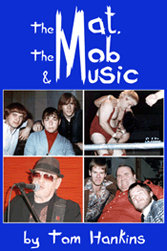
|
|
In 1963, I got into a fight with a kid my age when he took offense to me cheering for Bulldog Lee Henning. He took the first swing and I wrestled him to the ground. The police noticed the commotion and grabbed him, just as he pulled out a knife! I wasn’t even in the business yet and I had someone trying to beat and stab me.
Excerpt from "The Mat, the Mob & Music"
From 1965 to 1973, Tom trained hard with his friend, Dan Daniels, and made contacts in the world of pro wrestling until they were finally given a break by promoter Nick Gulas in Nashville. Billing themselves as the Reid Brothers — Crazy Charlie & Psycho Perry Reid — they found a spot for themselves in small promotions around the U.S. For the next decade, Tom split his time between wrestling, music, and managing a warehouse for Fat Eddie. The stories he tells of all three occupations are wild and filled with incidents involving women, alcohol, drugs and violence, many of which involve the infamous Dr. Jerry Graham, one of pro wrestling's most colorful characters.
In this narrative filled with personal anecdotes, Tom takes us behind the scenes to demonstrate just how much pro wrestling, rock 'n' roll, and the underworld have in common. Many of the stories are hilarious and he pulls no punches when writing about both friends and enemies. He talks about his interaction with wrestling legends — Andre the Giant, Lars Anderson, wrestling impresario Jack Pfefer, Moose Cholak, Jack Brisco, Gentleman Saul Weingeroff — and how he wound up as a guest on The Phil Donahue Show in the midst of the WWE sex scandal.
Crowbar Press is proud to present the story of one of the unsung characters of pro wrestling as he follows his dream.

|
|
|
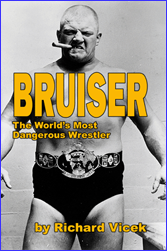
|
|
A former Green Bay Packer lineman who found more money and success in pro wrestling than he did professional football, Bruiser is a name people readily mention when talking about the golden age of the sport. Bruiser didn't languish for long in opening matches, and within a few months of his June 24, 1954, debut, Bruiser was cracking heads and pounding flesh in main events from coast to coast across the United States. Words that desribe Bruiser's in-ring style are believability, belligerence, domination, unpredictability, explosiveness, intensity, and rampage.
Bruiser's story may never have been told had it not been for author Richard Vicek's dogged determination to interview and correspond with hundreds of people who knew our Bruiser during various stages of his lifetime. They all shared their memories and experiences.
To wrestling fans, Bruiser was a intimidating bull of a man who put fear into the hearts of his opponents and could not be controlled by wrestling promoters. What they didn't know was, Bruiser was co-owner of a highly successful wrestling promotion based in Indianapolis, in which he served as both an executive producer and as the star performer of the show.
In all respects, Bruiser left an indelible mark in pro wrestling history that will never be matched in either longevity or significance. This book is a testament to the legacy he left behind.

|
|
|
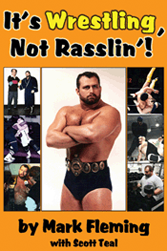
|
|
Mark didn’t get his spot in the wrestling business because someone paved the way for him. He got in the hard way. His first test was to make it through the grueling tryouts conducted by Gene and Ole Anderson. As everyone knows, Gene and Ole didn’t give any quarter. They showed the 27 wannabes just what they would be facing in the pro rings by rubbing their faces raw on the mat, stretching their limbs to the breaking point, and manhandling them so badly that many of them ran out of the arena without even collecting their street clothes. When the smoke cleared, only one man out of the 27 hopefuls remained standing … Mark Fleming.
It didn’t get any easier when Mark began wrestling for one of the biggest wrestling promotions in the world … Jim Crockett Promotions. During a time when the wrestling business was at an all-time high and record crowds were filling the arenas, Mark wrestled almost every major star that came through the Charlotte territory. The rigor of the road proved every bit as tough as Mark wrestled in 14 different states, Canada, and Japan.
Mark’s love for the wrestling game is evident in this book as he shares the story of how he and Lou Thesz, together, attempted to change rasslin’ back to what it had once been — WRESTLING!

|
|
|
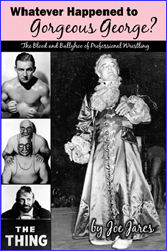
|
|
There is a world where truth, beauty, and innocence battle nightly with the insidious, subterranean forces of evil — evil in the guise of The Beast, The Crusher, and the Missouri Mauler, truth embodied in The French Angel, The Golden Superman, and Chief Big Heart. It is the world of pro wrestling.
"Whatever Happened to Gorgeous George?" is the story of the most outlandish personalities in sport—comic book figures with fanatical followings. Here you’ll meet Gorgeous George himself, Bruno Sammartino, Haystack Calhoun and a host of other arch-villains, prissy lords, masked marauders, and muscle-bound mamas. Loving and hating them along the way are the maniacal fans who follow them and turn the arenas into screaming, roving Theaters of the Absurd—Piccolo Pete, Hatpin Mary, and the septuagenarian sisters from Baltimore, to name a few.
"Whatever Happened to Gorgeous George?" is the definitive inside story of pro wrestling, complete with a chronology of the sport and biographies of the greatest wrestlers. It is also a collection of some of the wildest stories ever told, and a funny, irreverent look at the most colorful, theatrical sport on the American scene.

|
|
|
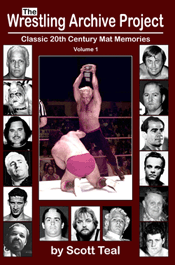
|
|
For years, readers have been asking us to reprint the interviews featured in the classic "Whatever Happened to ...?" magazines. In what will be an entire series of books filled with interviews, both old and new, we are now publishing all the interviews we've done with the professional wrestling legends of yesteryear!
Scott Teal conducted most of these interviews in the days of "kayfabe," a time before anyone else was getting the inside scoop on the business of professional wrestling, and most of the people he talked with have never been interviewed by anyone else.
The "MAIN EVENT" for the first volume is a 117-page, never-before-published, interview with BUDDY COLT. Two other exclusive interviews never-before seen in print are with Adrian Street and Mac McMurray. Filling out the 406-page book are interviews with Benny McGuire, Dandy Jack Donovan, Dick Cardinal, Frank Martinez, Gene Dundee, Gene Lewis, Gorgeous George Grant, Ernie "Hangman" Moore, Joe Powell, Lord Littlebrook, Lou Thesz and Pepper Gomez. They open up to Scott with details about their lives and careers as they have with no one else — before or since.
Go behind the scenes with the true legends of professional wrestling with indepth, hard-hitting, no-holds-barred interviews.

|
|
|

|
|
Don Fargo is one of the overlooked stars of the classic era of pro wrestling. He was a headliner in almost every territory in which he appeared — New York, Amarillo, Dallas, Tennessee, Buffalo, Detroit, Indianapolis, and Louisiana, just to name a few.
For the first time, Don tells, in detail, the story about what happened when he and his tag-team partner ran afoul of a group of motorcycle outlaws, and how he inadvertently wound up on the wrong side of the law on more than a few occasions. He also tells stories about pulling ribs on his fellow wrestlers, including well-known celebrities like boxing champ Joe Louis, and classic, hilarious stories about many of the well-known wrestlers of the golden era of pro wrestling. Don tells the story about how he met Jackie Fargo, how they formed the tag team that became known as the Fabulous Fargos, and the story behind how they became the first team to be billed as "world tag team champions" in Madison Square Garden.
This is the most detailed book ever written that ties together important events in wrestling history with the hilarious shenanigans that went on behind the scenes. You’ve never read a more entertaining life story than this one.

|
|
|
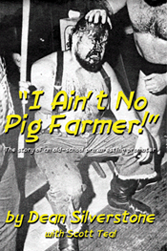
|
|
In an era when few people were allowed into professional wrestling’s inner circle, Dean Silverstone pitched the idea of publishing an arena program to Harry Elliott, the wrestling promoter in Seattle, Washington. Harry gave him permission and Dean’s career as a wrestling publicist began … when he was only 14 years old.
An entrepreneur in every sense of the word, Dean wrote, created, printed, and sold the programs at Seattle’s Senator Auditorium and Masonic Temple for the next 11 years. During that time, he also would promote spot shows, referee, write and handle publicity for Elliott’s promotion, act as box-office manager, and run a few towns of his own.
Dean tells about putting together a roster of talent and struggling to build his company, despite opposition from other promoters, who considered him to be an outlaw. In the process, he faced anti-Semitism, unpredictable actions from his talent, crowd riots, warnings from the Hell’s Angels, collapsing rings, the tragic death of one of his top wrestlers, and even a Molotov cocktail. Through it all, he developed a rapport and trust between himself and the wrestlers he employed.
This is the story of a self-made man, who, in his own words, was "born at just the right time in history."

|
|
|
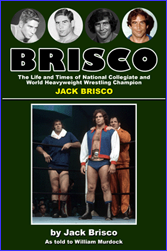
|
|
Few people in history have made their mark in more than one field, but Jack Brisco was a three-time champion in three different walks of life.
AMATEUR WRESTLING – NCAA heavyweight champion in the 191-lb. class in 1964.
PROFESSIONAL WRESTLING – National Wrestling Alliance world heavyweight champion from 1973 through 1975.
HUMAN BEING – He set the standard for what people should aspire to be — humble, honest, and sincere.
Raised in Blackwell, Oklahoma, Jack grew up as a fan of professional wrestling. In 1965, he won the NCAA national wrestling championship in the 191 lb. class. He had his first professional match when he wrestled Ronnie Garvin on television in Oklahoma City on May 15, 1965. During the next 20 years, he was regarded as one of the top names in the wrestling business. He won both the Southern and Florida heavyweight titles during his time in Florida (among many other titles) and took the NWA world heavyweight title from Harley Race in Houston on July 20, 1973. Later, he and his brother, Jerry Brisco, became top draws in Florida, Georgia and the Mid-Atlantic territories.
Jack and Jerry bought into the Georgia Championship Wrestling company and were responsible for convincing other shareholders to sell their shares to Vince McMahon, setting into motion Vince's dominance of the wrestling world.
This updated version of the original printing, brought to you by Crowbar Press, is Jack's life story. It includes all the background details from his rise to super-stardom to his quiet retirement at a young age. Just the background stories of how he came to win the various titles he held are worth more than the price of the book.

|
|
|

|
|
Nikita Koloff, better known as the "Russian Nightmare," stormed the wrestling world as few others have in the history of the sport. Imposing, immovable, and unbeatable, Nikita left a trail of fallen opponents as he brought the Cold War that loomed over the globe into the ring.
From a hard-scrabble beginning to rings around the world, Nikita Koloff filled arenas, thrilled fans, and captured five world titles in the process. And then, when he was at the top of his game, he walked away from the sport.
This is not just the story of Nikita Koloff, the wrestler. It is the story of Nikita Koloff, the man. It is the story of a remarkable and unique journey. It is a story that, in many ways, is common to all of us.

|
|
|
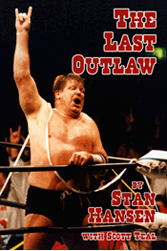
|
|
In addition to the stories about his time in the U.S., Stan Hansen's account of his wrestling career is a veritable guidebook of professional wrestling in Japan. In "The Last Outlaw," he tackles every subject imaginable as he educates and entertains readers with his stories about the promoters and their promotions, how the Japanese promoters operate their business behind the scenes, touring the country on the wrestling bus, the nightlife in the big cities, and how the sport in Japan differs from that in the U.S.
He goes into detail about his time in the AWA, how he came to win the AWA title, his confrontation with Verne Gagne prior to walking out, and what he really did with the title belt when he left the territory. Stan tells about wrestling in the WWWF, giving a detailed description of the match in which he broke Bruno Sammartino's neck, the matches that followed, and the subsequent problems he had with Vince McMahon Sr.
And what would a "Stan Hansen book" be without personal stories about the time he spent with Bruiser Brody: how they first met, the story behind their becoming a team, spending time in the evenings on the streets and in the clubs of Japan, and his own, personal insight into the "real" Bruiser Brody.
Travel down the road with Stan Hansen — The Last Outlaw.

|
|
|

|
|
Who was the greatest pro wrestler of the 20th century?
The debate is a real one among those who seriously study the history of this American pop-culture creation. Like the arguments over any effort to crown "the greatest," "the best," or "the worst," that answer is unlikely to ever be resolved to everyone's satisfaction. One fact is indisputable, though. For those who watched wrestling before it became "sports entertainment," there is only one answer — Lou Thesz.
In the late 1940s and well into the 1950s, he was the world heavyweight champion of the National Wrestling Alliance, its standard-bearer, and he carried those colors with dignity and class. "My gimmick was wrestling," he said, and it was evident to anyone who ever bought a ticket to see Lou Thesz that he was the real thing.
This is "no holds barred" material — far more open and truthful than anything ever written about professional wrestling.

|
|
|
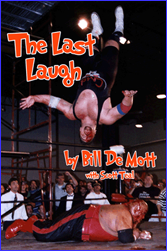
|
|
According to Bill De Mott, he was just a "fat kid from Jersey who had never been out of the country," but his introduction to professional wrestling in 1988 has allowed him to travel all over the world. Since then, he has been a professional wrestler, a color commentator on the WWE Velocity television show, the head trainer for Deep South Wrestling (WWE’s developmental territory), a trainer on three seasons of the television reality show, Tough Enough, and now the owner of his own wrestling school and promotion — New Energy Wrestling.
Bill leaves no subject untouched. He discusses the origins of his many characters: Big Sweet Williams, Crash the Terminator, Crash the Eliminator, The Man of Question, Hugh Morrus, and General Rection. He talks about taking (and failing) drug tests. Bill doesn’t hesitate to criticize himself, either, and relates his shortcomings. He talks candidly about making bad choices in life and his search for closure. He tells about being a member of the Chubba Bubbas, a group of wrestlers which included Rocco Rock, Johnny Grunge, Devon Storm, and Joe D’Acquisto, whose primary goal was to party and have fun … and, more often than not, get into trouble in the process.
Considered by many to be a taskmaster with high expectations for his students, a softer side of Bill also reveals itself as his story unfolds. He speaks passionately about life on the road and how he missed seeing his two daughters grow up. In addition, Bill shares the actual notes from the journals he kept during his time on the road.

|
|
|
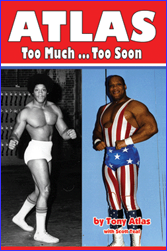
|
|
During a time when "wannabe" wrestlers trained for years for the opportunity to become a pro wrestler, Tony Atlas was the first wrestler to be paid to learn his trade. By the late ‘70s, Tony was one of the biggest names in the sport and was wrestling in front of sellout crowds in the largest arenas in the country. While wrestling for the WWF in 1981, he even pinned Hulk Hogan in Madison Square Garden.
Readers will feel like they are living Tony’s life through his eyes as he tells about his free-spirited and self-destructive journey through life. His out-of-the-ring stories are as compelling as those that took place inside the ring. Tony tells about growing up in poverty, and recounts stories from his childhood: his dad encouraging him to fight for money as a child, being sent to a juvenile detention center, and being introduced to sex at the age of 16 by a 38-year-old woman. He describes his introduction to wrestling, his rapid rise to the top echelon of talent, the rampant and easily-available sex, money, and drugs, his fascination with "shoes," and the terrible toll his lifestyle took on his personal life.
This is the story of a man who had success handed to him—only to throw it all away—and the long, painful struggle he had to endure as he clawed his way back to the top.

|
|
|
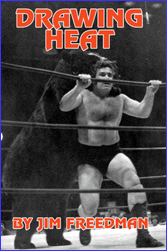
|
|
First published in 1988, Drawing Heat was one of the first books to really give the public a glimpse behind the scenes of the world of professional wrestling. Jim Freedman, a Professor Emeritus at the University of Western Ontario who also consults on international development for the United Nations, CIDA, and international NGOs, seems an unlikely candidate to write a book on such a subject, but he paints a captivating portrait of the sport.
Welcomed into the inner circle by nearly everyone associated with the promotion, Jim presents an insiders look at what it took to promote a small, independent wrestling show ... putting the show together, setting up the ring, counting the money and balancing the books, ring announcing, dealing with sports commissioners who are in the pocket of the big wrestling companies, and what it is that lures wrestling fans into the arenas.
Filled with wonderful characters, the action in this book far outweighs anything seen in the ring today. Dave "The Wildman" McKigney, the main character, is the owner of the Big Bear company, and the struggles and tragedies he faces become the focus of the narrative. Known for traveling with his wrestling bears, one of the most heartbreaking stories in the entire book details the account of McKigney’s girlfriend when she is mauled to death by one of them.
In addition to the original text, this reprinting features two additions:
An interview with the author: Jim Freedman — The Final, Fateful Bearman Tour

|
|
|
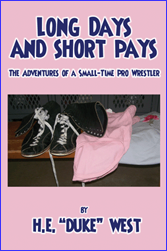
|
|
By his own admission, H.E. West was never what you might call a well-known name in professional wrestling. He never wrestled in Madison Square Garden, he never held a championship title, and the small amount of money he was paid seldom covered the expenses he incurred on the road. For all intents and purposes, wrestling was not much more than a hobby, but he was doing what he loved.
West's story is a captivating look at life on the road for a man whose only desire was to be a part of the world of professional wrestling, not matter how small or insignificant that part might be. He takes the reader along with him on his journey into the wrestling world, describing his time in the ring, wrestling in high-school gyms and armories before fewer than one hundred people, and on the road with his fellow wrestlers. West wrestled as Mean Duke West, The Creature, and his most high-profile character, the Canadian Rose. He talks about being cheated by promoters, and being paid as little as one dollar a match. The narrative is peppered with honesty and humor, and told with humility by a man who never makes himself out to be more than he was — a wrestler whose sole purpose in the ring was to make other wrestlers look good.
His story comes to a close as, with the advent of Vince McMahon and World Wrestling Entertainment, he watches the wrestling business change around him, and as the independent promotions go out of business, he finds himself standing on the outside of the wrestling business and looking in.
This is the story of a man who sacrificed and did what it took to achieve his childhood dream — to be a "professional wrestler."

|
|
|
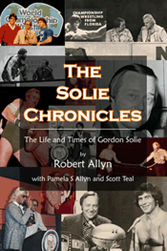
|
|
Since the late 1800s, professional wrestling has turned out many high-profile stars: names such as Frank Gotch, Ed "Strangler" Lewis, Lou Thesz, Dusty Rhodes and Hulk Hogan. Perhaps one of the most well-known pro-wrestling personalities, however, wasn't even a wrestler. He was a commentator and announcer named Gordon Solie.
Famous dead-pan style interviews and colorful play-by-play broadcasts of wrestling led to Gordon’s induction into the WCW Hall of Fame (Class of 1995), the NWA Hall of Fame (Class of 2006), and the WWE Hall of Fame (Class of 2008).
The background material for this biography was found in Gordon's personal files and taken from interviews with the people who knew him the best. It is written as a testament to a man who made his mark in many endeavors.

|
|
|
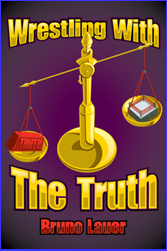
|
|
"Wrestling with the Truth" is the title of this book, but it doesn’t mean what you think it does. Bruno Lauer has no problem telling the truth. He believes in telling it like it is, and after spending 29 years as a manager in the business of professional wrestling, he has a lot of stories to tell.
The story of Bruno Lauer, known professionally as Downtown Bruno and Harvey Wippleman, relates the fascinating, and often hilarious, story of his life. Direct and opinionated, he doesn’t hold back anything, sharing both the good and the bad things that happened to him. Even his close friends aren’t safe from his scrutiny. Take it from Mick Foley, who read the first draft of the book and found himself on the receiving end of a few barbs thrown by Bruno: "Bruno's honesty can be, at times, a little painful."
As he retraces every step of his career, Bruno’s account of his life as a "sports entertainment" performer begins at age 13, when he joins a traveling wrestling troupe at a carnival, and ends when he wins the WWF "Women’s" world championship wrestling title on prime-time national television.
This autobiography is a fresh glimpse of life behind the curtain of professional sports entertainment. As full of action, entertainment, heartbreak, and drama as anything that takes place inside a professional wrestling ring, Wrestling with the Truth is the story of a man who struggled to find his place in the wrestling business, and the success that came through his perseverance.
With a Foreword written by Dwayne "The Rock" Johnson
[excerpt] Bruno Lauer and I have shared an extraordinary friendship that has spanned more than 20 years. Throughout that time, the same words come to mind when I think of Bruno — loyal, reliable, and as funny as hell!

|
|
|
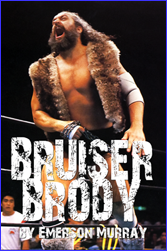
|
|
Today, more than 18 years after his death, professional wrestling fans still talk about Bruiser Brody with reverence and awe in their voice. Hardcore fans consider him to be the greatest brawler in the history of the sport.
Frank "Bruiser Brody" Goodish was known as a brawler, a wild-man, and an outlaw. His style and character have been copied by countless other wrestlers. Mick Foley (Cactus Jack/Mankind), whose name is synonymous with the hardcore style of wrestling, claims to have studied Brody’s Japan tapes for hours while training to be a pro wrestler, and patterned his ring style after him. However, like the old saying, "Often imitated, never duplicated," that applies to Bruiser Brody. There will never be another one like him.
In 1988, Brody was murdered in a dressing room in Puerto Rico—by one of his fellow wrestlers!
This book is the story of Bruiser Brody, told in the words of those who knew him best—childhood friends, family members, fellow wrestlers, photographers, and newspaper reporters. No punches are pulled and the rulebook has been thrown out. This is THE definitive … Bruiser Brody!

|
|
|
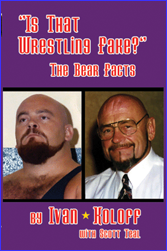
|
|
For decades, professional wrestling fans have asked the question – "Is that wrestling fake?"
However, they wouldn't have dared ask that question directly to Ivan Koloff, whose work in the ring made believers out of the most cynical viewers.
Growing up on a farm in Ontario, Ivan learned the meaning of hard work and discipline. Unfortunately, he made wrong choices and wound up in prison for cattle rustling. Upon his release, he enrolled in a wrestling school and began a career in pro wrestling as Red McNulty, the Irish Rogue.
Five years later, on January 18, 1971, he appeared in Madison Square Garden under the name Ivan Koloff and did what had never been done before. He pinned Bruno Sammartino's shoulders to the mat and won the WWWF heavyweight title. When the referee called for the bell, you could have heard a pin drop as the more than 21,000 screaming fans were instantly moved to a stunned, disbelieving silence.
Here for the first time, Ivan tells the story of his life: the highs and the lows; his admission of alcohol and drug abuse; reflections of a life spent on the road, and the toll it took on his body and soul; the event in Kannapolis, North Carolina, that changed his life forever.

|
|
|
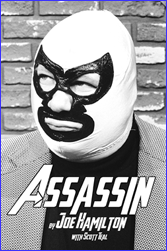
|
|
Get behind the mask and into the head of one of professional wrestling's most famous masked men. This autobiography of Joe "Jody" Hamilton takes the reader behind the scenes for a personal glimpse behind the mask of one of pro wrestling’s hottest attractions —
THE ASSASSIN!
When Joe Hamilton was just 19 years old, he and his brother, Larry, headlined a show at Madison Square Garden, drawing a record 20,335 people to see them wrestle Antonino Rocca and Miguel Perez. To this day, Joe remains the youngest wrestler to ever headline a main event in the Garden.
In 1961, Joe hooked up with veteran wrestler Tom Renesto to form a team called the Assassins, and for the next eleven years, they were considered to be one of wrestling’s hottest attractions, drawing sellout crowds to arenas in California, Georgia, Florida, Oklahoma, North Carolina, South Carolina, Virginia, and Washington, in addition to foreign countries like Japan and Australia.
Joe takes readers on a journey as he tells about life both in and out of the wrestling ring—being attacked, stabbed, and shot at by angry wrestling fans; wrestling under a mask and trying to keep his identity a secret; legitimate fights and confrontations behind the scenes in the dressing rooms; a war between two wrestling promotions in Atlanta, Georgia; and never-before-told stories.

|
|
|
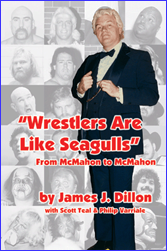
|
|
For more than 40 years, James J. Dillon has been involved in the world of professional wrestling. Now he speaks candidly on all aspects of both his career and his personal life.
This book has something for wrestling fans of all generations and ages as J.J. Dillon offers a first-hand account and detailed history of one of the most influential wrestling promotions in wrestling history — the World Wrestling Federation. For 7½ years, JJ served in the WWF as Vince McMahon's top lieutenant, right-hand man, and Vice President. Never before has someone from McMahon's inner circle written a book with an insider's perspective of the company.
JJ also gives a insider's perspective on the ludicrous business decisions made by executives who took World Championship Wrestling down a path that led to the company's destruction and eventual demise.
From the highs of making big money, winning championship titles, rubbing elbows with top celebrities, and appearing on television every week — to the lows of filing for bankruptcy, extramarital affairs, divorces, and drug use — no stone is left unturned when J.J. Dillon tells his story.
In this book, there are truly "no holds barred."

|
|
|
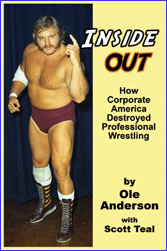 |
|
Here, for the first time, Ole Anderson finally tells his story. The people who know him, know that Ole is never hesitant to speak his mind — and this book is no exception.
Combining facts and opinion, Ole's biography is a straightforward look at the many phases of his career in the wild, if somewhat seedy, world of professional wrestling. From his days in amateur wrestling, to the time when he hooked up with Gene and Lars Anderson as the Minnesota Wrecking Crew, Ole relates 30-plus years of never-before-told stories.
Ole tells of his feuds, both inside the ring and out, with people like Ric Flair, Wahoo McDaniel, Mr. Wrestling, Dusty Rhodes, and Bill Watts. However, his biggest feuds took places behind the scenes in the halls and offices of corporate giant, Superstation WTBS. The matches in the ring were nothing compared to his battles with The Suits, corporate executives like Vince McMahon, Jim Barnett, Bill Shaw, Jim Herd, and Eric Bischoff. In Ole's own words, "The wrestling matches may have been staged and scripted, but there was nothing ‘fake' about the corporate and legal battles."
As a former wrestler, booker, promoter, owner, and executive producer, Ole goes deeper in the inner workings of professional wrestling than anyone ever has. He tells the stories about financial, legal, and drug problems that plagued the wrestling business.

|
|




































